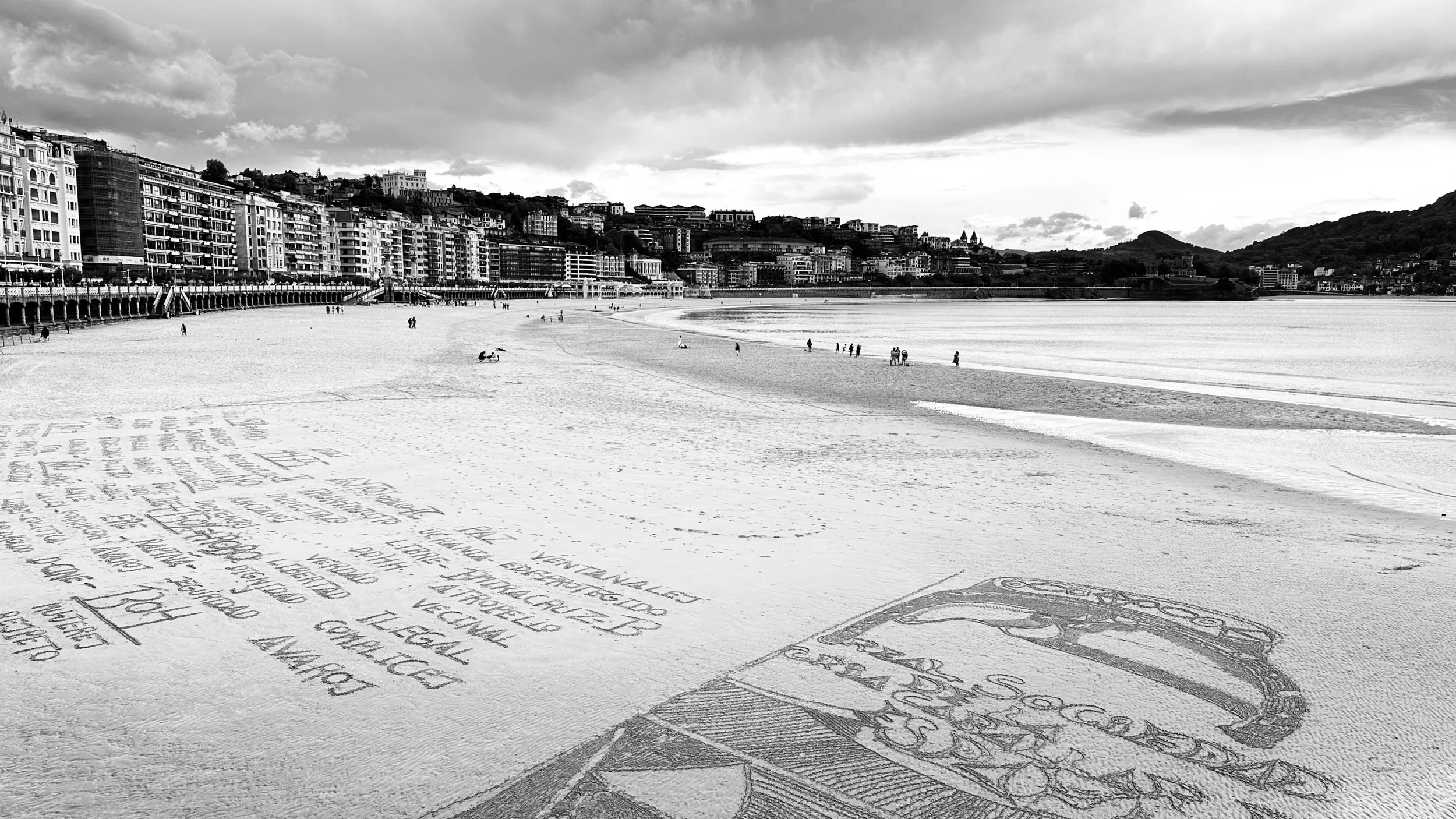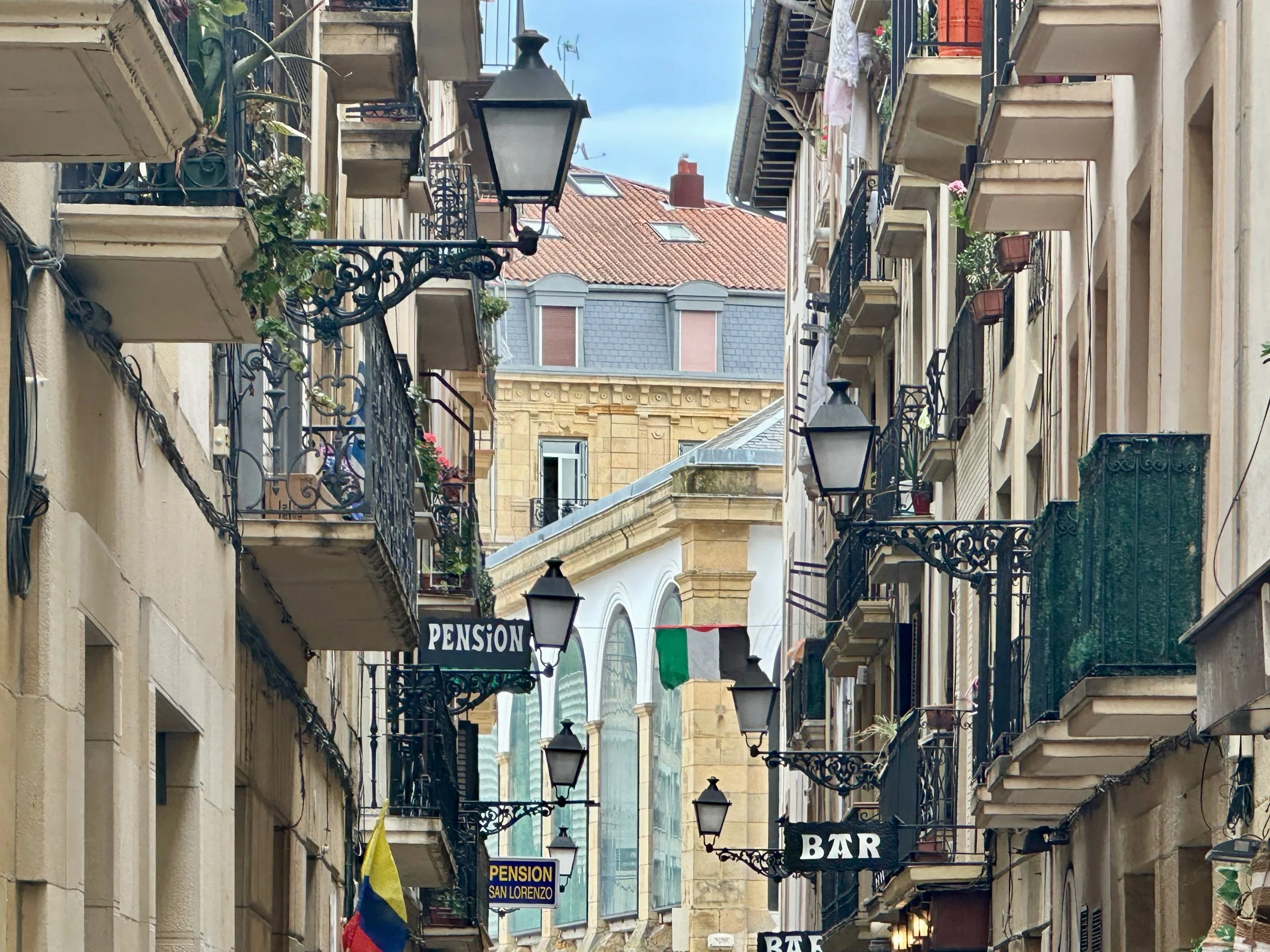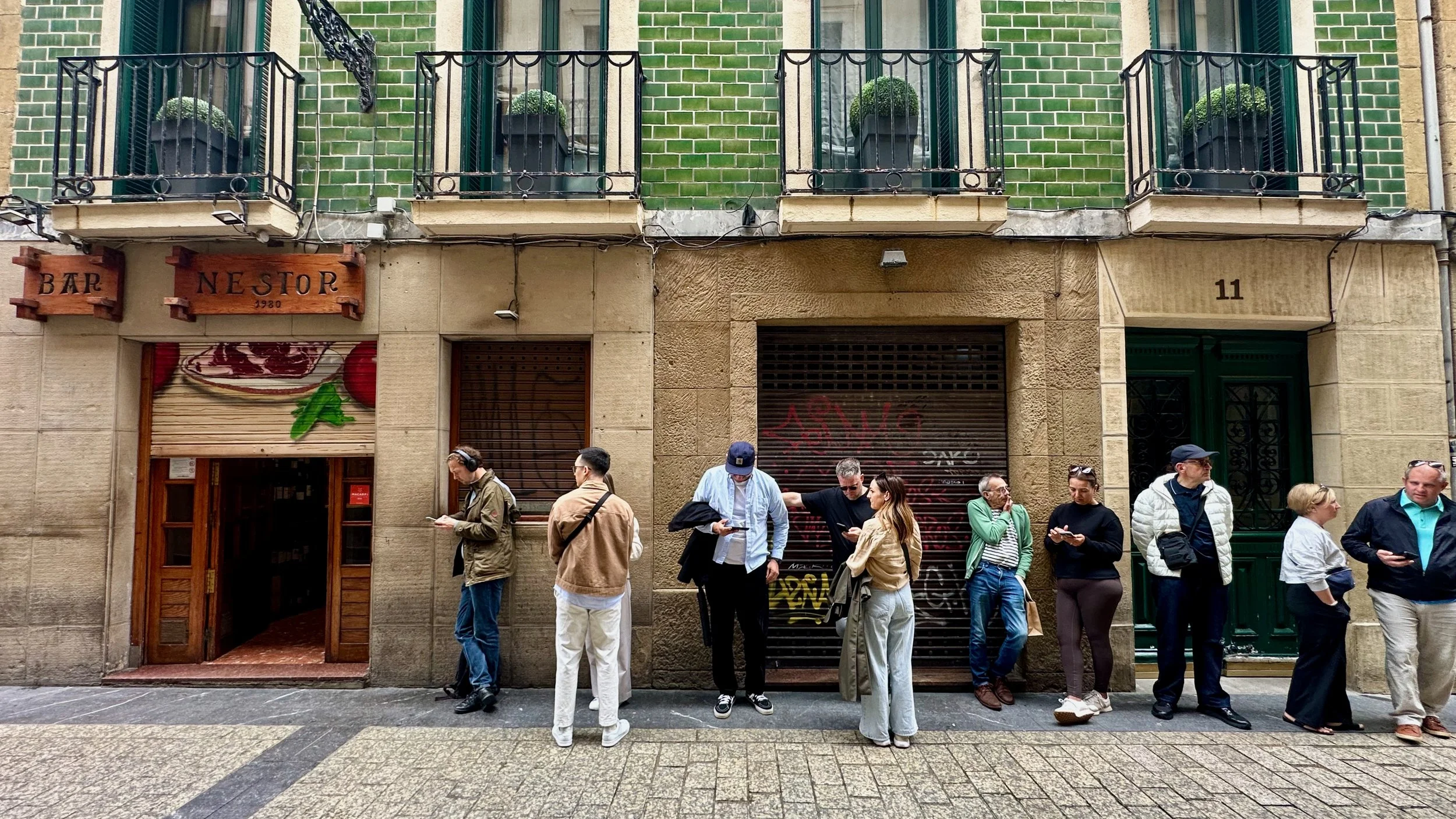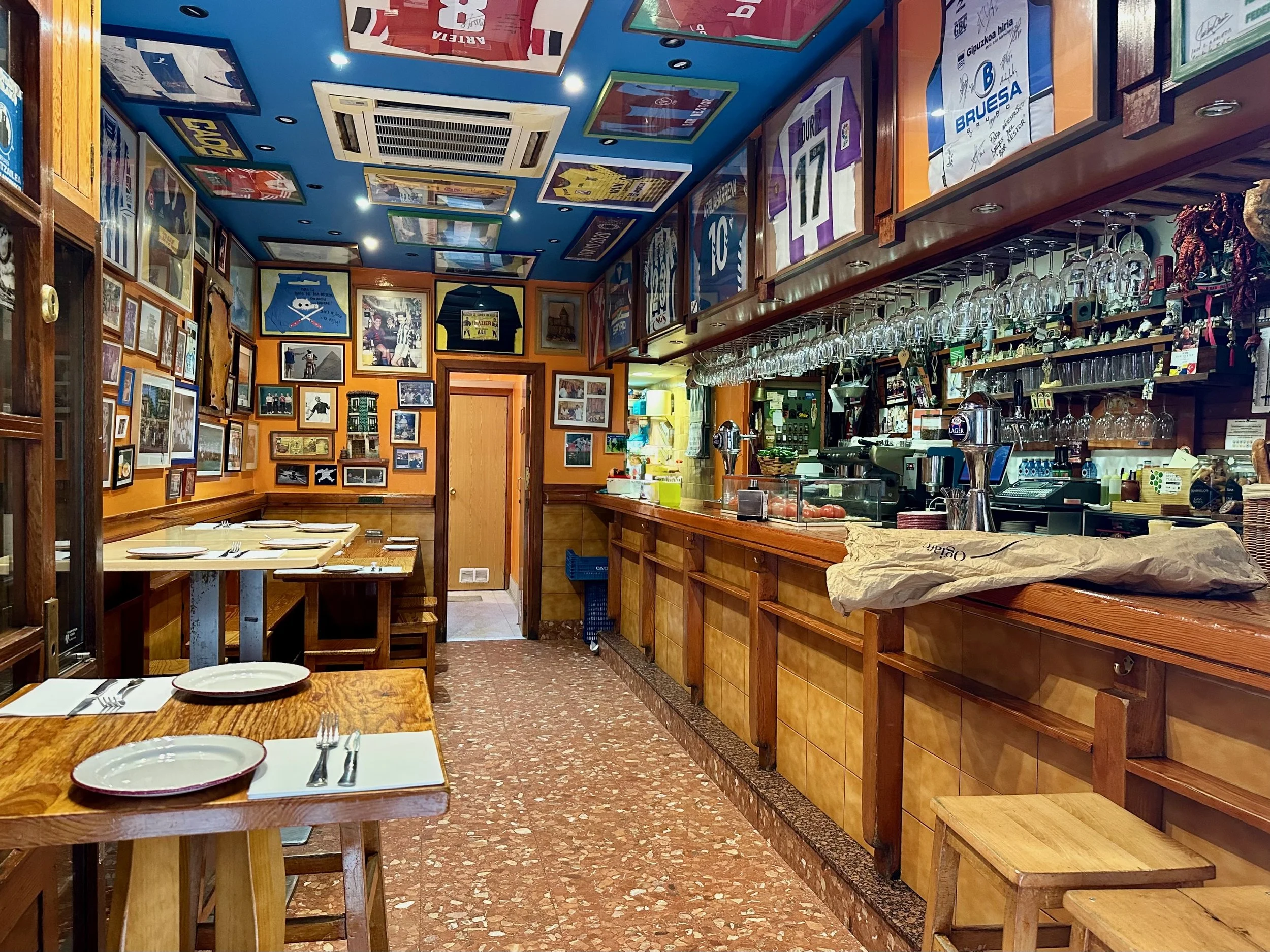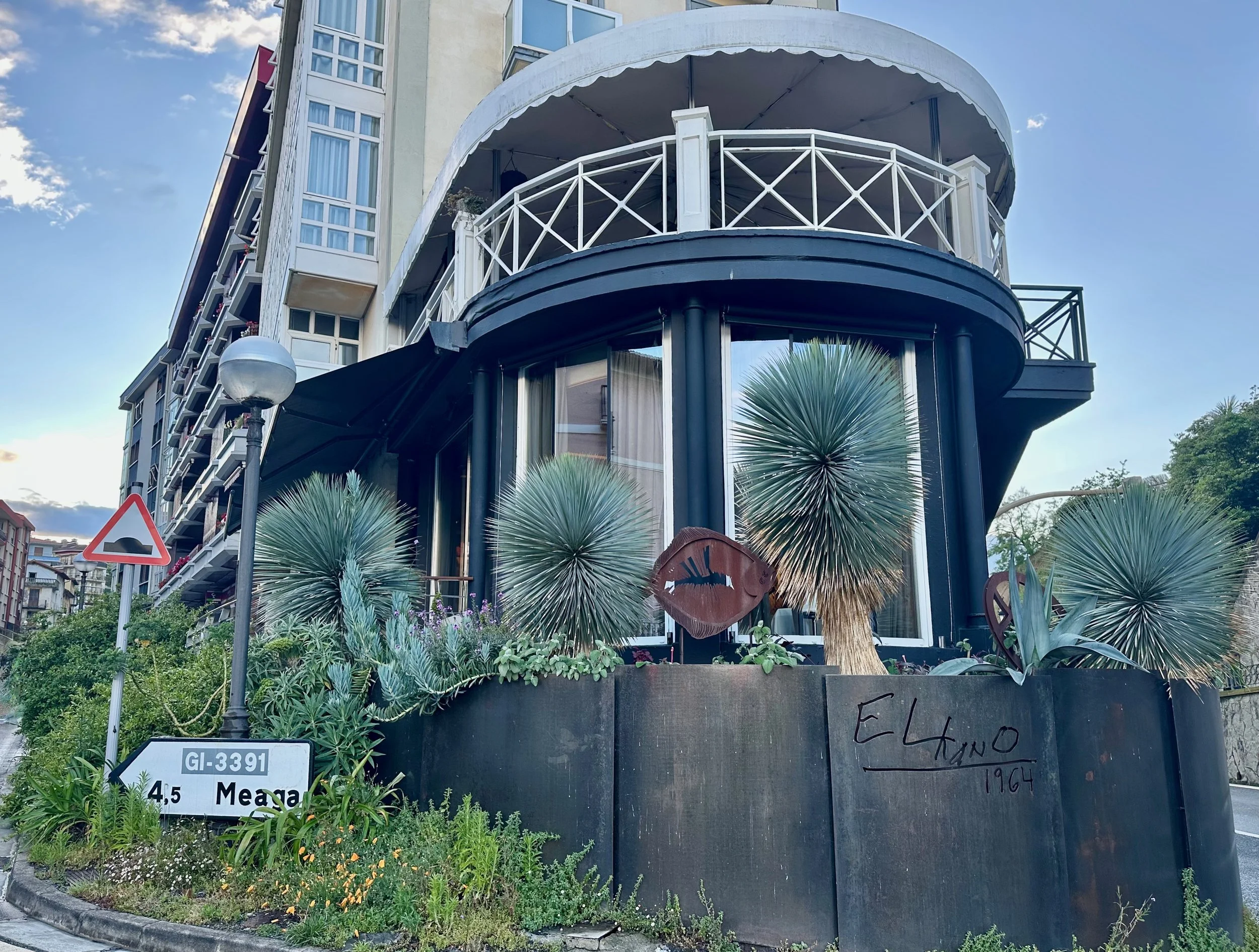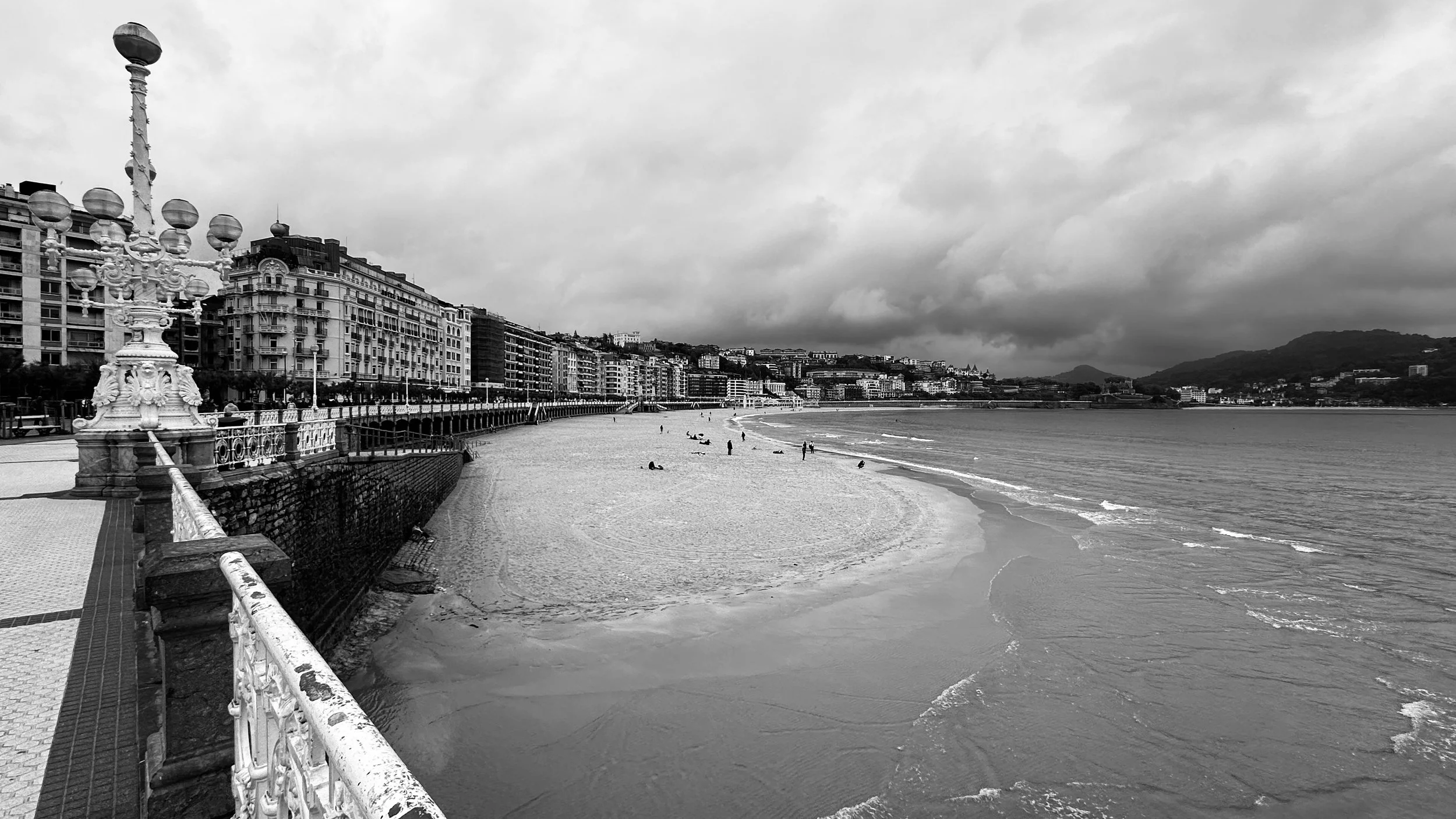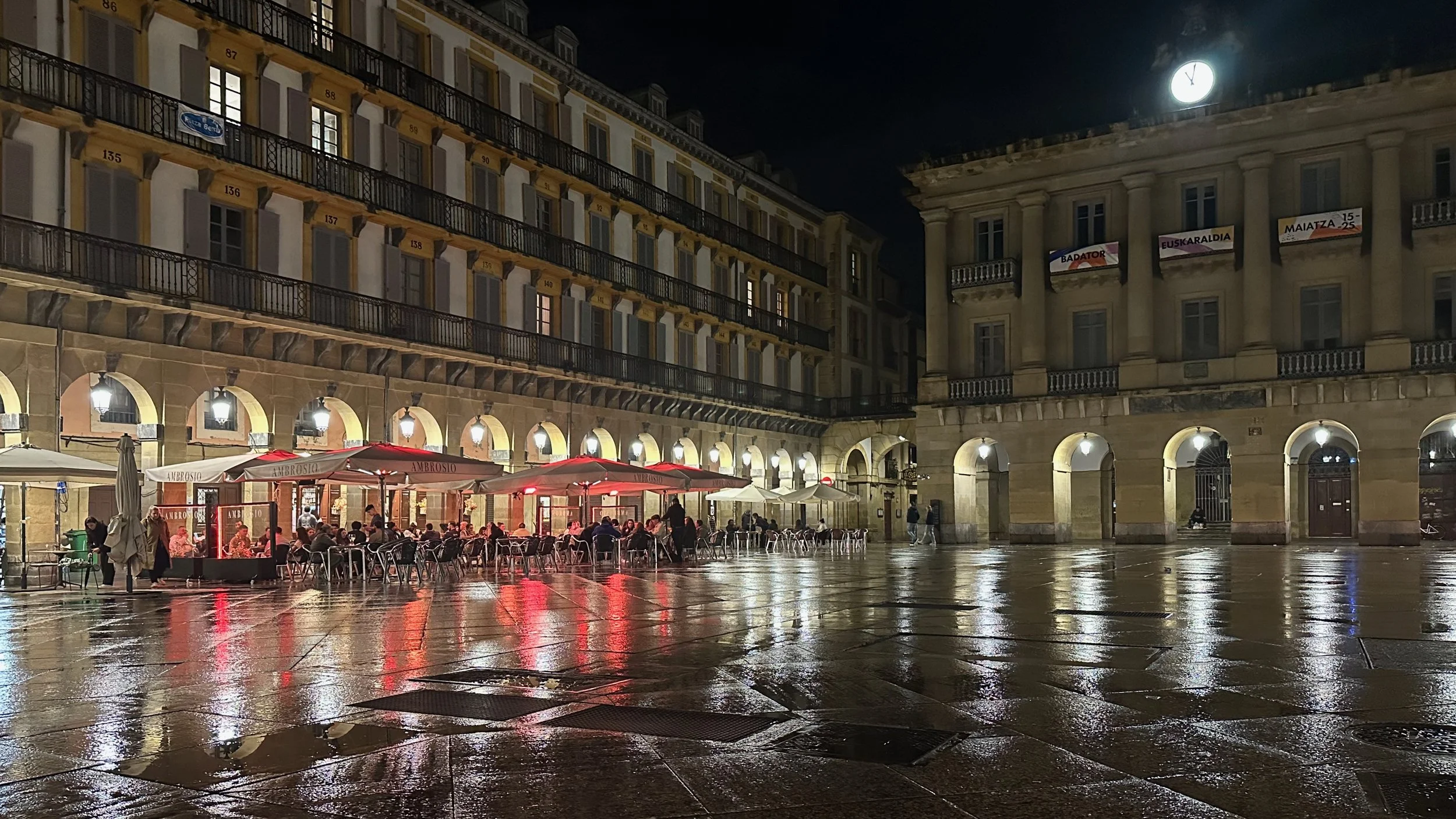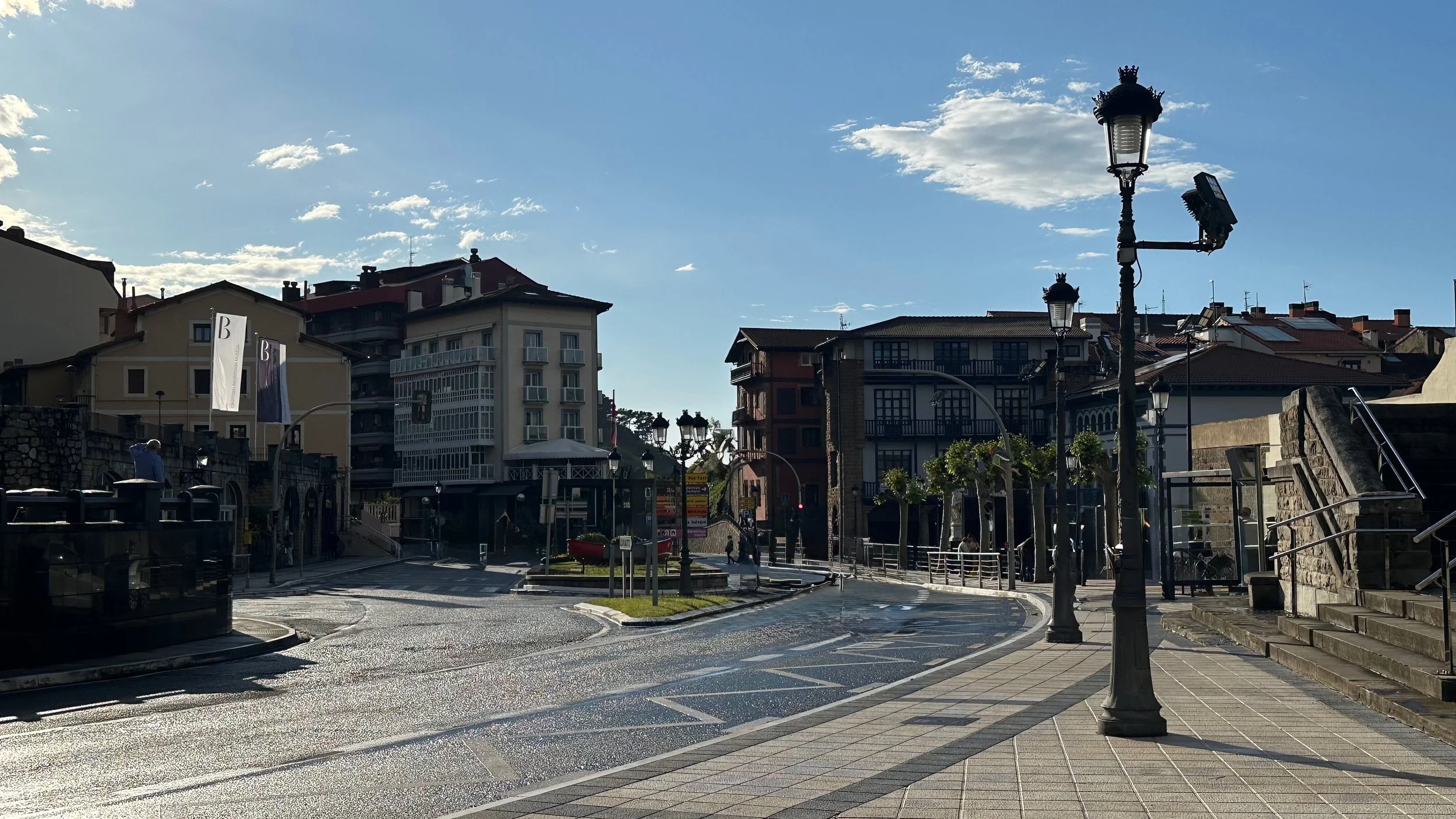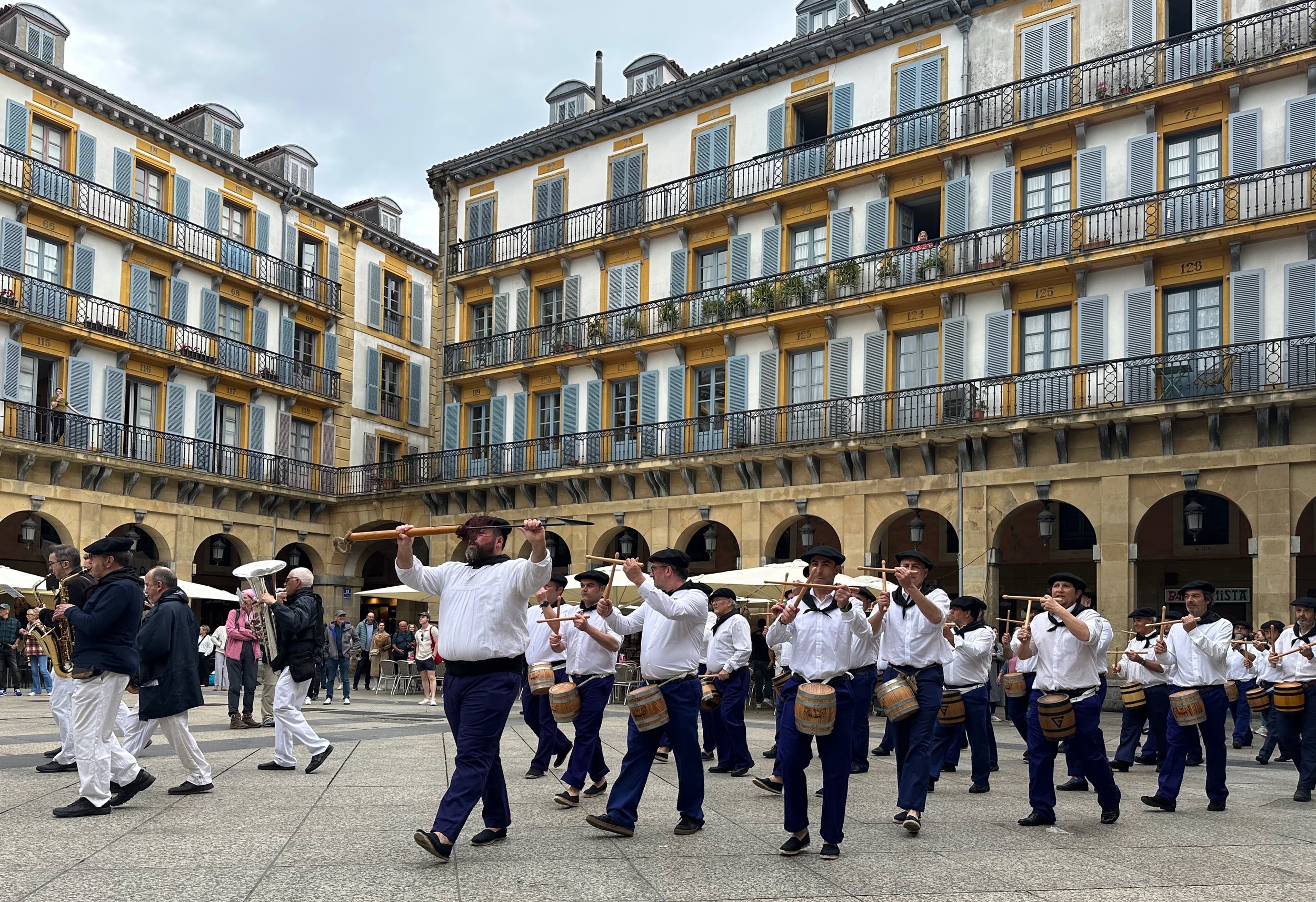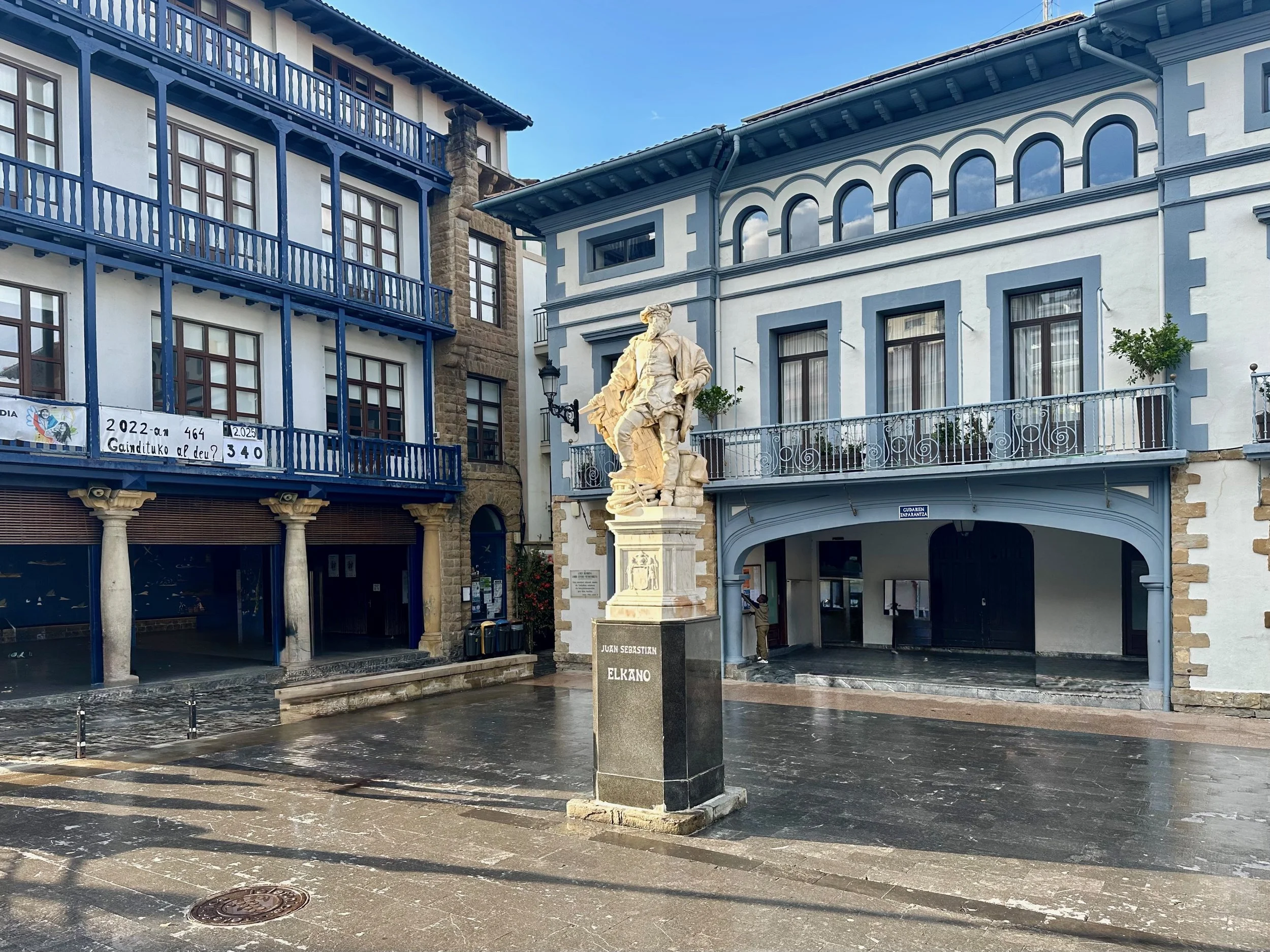San Sebastián & Getaria
09, 10 & 11 May 2025
Pintxos is the Basque version of Tapas, but infinitely superior according to the mysterious and genetically unique people who inhabit southwestern France and northwestern Spain. So as the temperature remains stubbornly low and it pisses down with rain, I roll the bike down the ramp to an underground car park near the famous crescent beach, slap bang in the centre of town before finding where my pals are, who have flown in for a sort of ultimate Basque Dining Extravaganza Weekend.
According to any number of foodie TV programmes and amateur pundits, San Sebastián is the place to go to get the very best Pintxos. Inevitably, such universal adulation tweaks a level of scepticism, but it is worth setting this to one side on this occasion as it’s about the most perfect dinner imaginable.
We seek out specific bars, famous for specific dishes: a mini-baguette of tuna with green pepper and a tortilla in Bodega Donostiarra; a single, humbling anchovy of a slice of garlic baguette topped with a chunk of red pepper at Bar Astelena, then a small bowl of artichoke soup in Casa Urola; moving on for spider crab in pastry bites in Bar Ganbarra and then onto La Cuchara de San Telmo for Morcilla (local Black Pudding), a square of crispy roast pork, some seared foie gras and, finally, scallops topped with a single disc of chorizo and served with orzo resembling risotto.
The tableau for this gastro-orgy is the network of rectilinear, largely pedestrianised streets behind the Plaza de la Constitucion and a simmering stew of enthusiastic tourists and welcoming locals. Despite the hordes, in no bar are you left with an empty glass before a grinning waiter sloshes a generous measure of Txakoli (slightly fizzy white) or something utterly unpronounceable and red, or plonks down a couple of plates of something delicious before finally presenting you with a stupidly low, unitemised bill there is no point in checking. So you just tap to pay and lurch on to the next place. Bliss. We call it quits on eating at about eleven and sit with cleansing local beers in the square, newly washed by one of the frequent heavy downpours.
Next morning, and against all expectations, one of our number (an otherwise saintly man, but not one famed for patience and whom I have never seen queue for anything) has diligently turned up at 11:15 in the morning and is eighth in line at 11 Arrandegi Kalea.
Why? The answer is Bar Nestor, established in 1980, and famous for making The Best Tortilla in the World. After waiting forty-five minutes, a shutter opens and the queue shuffles forward in patient and nervous expectation. Our proxy places an order for four pieces and gives his name, which is scribbled in pencil on a scrap of paper. Only sixteen portions are available each day, and he’s bagged portions eleven to thirteen inclusive and instructed to come back at 12:45, which we duly do after a coffee and a deeply patriotic marching band display in the nearby Plaza de la Constitucion.
As the door of Bar Nestor swings open for business proper at 12:45, a heavy silence descends on Arrandegi Kalea, leavened by nervous expectation of those who have returned as directed. The man who took the orders calls out the names of the fortunate few in the order of the original queue. Some even punch the air as their names are read out, but I suspect they are American.
And then, once in and perched at the bar, you get it: one small slice of pan-fried egg and half-cooked potatoes on a small plate with a hunk of bread. Can it be worth the faff?
F*** yes— even knobs like me who sigh and claim (without really believing it, but just wanting to behave like a superior knob in a knob’s world) that the tortilla at Barrafina (Soho, London) is a pale imitation of that at Cal Pepe (Barcelona, Catalonia) are justified to claim this dish is elevated to an improbable level. If subject to some molecular deconstruction process or whatever, I suspect it would look much the same as any other tortilla, but you just have to take my word that it just isn’t. Go. Take your place in the line and get your once-in-a-lifetime taste. Or better still, get somebody else to queue like I did.
We top it off with some skewered anchovies and marinated green peppers and a big plate of beef tomato. This last plate looks like an asylum inmate has cut them up with a wooden spoon before his arsonist cell-mate soused them in olive oil. You don't come to Nestor for their presentation skills. The finishing touch is a sprinkling (well, more like a fist-full) of dandruffy salt crystals. And there you have it, along with a swift half of beer, that’s it: simple perfection.
With having ‘peaked too early’ a distinct risk, we walk off lunch around the lovely bay before driving down the coast to Zarrautz and check into a simple hotel. A taxi ferries us to nearby Getaria where we have a reservation at Elkano. This fabled seafood restaurant has an ethos unchanged since opening in 1961: serve the best seafood from the boats that bob about in the harbour catch that day and waste nothing.
There is no point describing what we had because I’m writing this the day after. It’s a Sunday, so they’re not open and, even if they were, it would not be the same tasting menu as this changes daily according to produce. So the only salient criticism I can offer is: if you really, really, really love seafood, go; as this is a Bucket List Mecca. I doubt there is any other restaurant that can capture the elemental bounty of what covers two-thirds of the globe like these people can.
It’s quite a serious place though: the son of the original owner patrols the dining room, marshalling staff and offering frequent, detailed explanations of the dishes without a trace of false bonhomie. This is clearly his calling and a sacred responsibility. Likewise, the sommelier listened carefully to a fairly wide range of preferences from all four of us then somehow nailed it with his recommendation of two bottles without going through the €100 a bottle barrier, although breaking this fifteen times over is an option if you are so inclined. Even exercising some restraint, Elkano is very expensive (€1,100 for four), absolutely single-minded and undoubtedly worth every peseta.
The next morning, I take the coast road back through Getaria that clings to the rock face like California’s Pacific Coast Highway. It goes all the way to Bilbao but with one eye on the clock, I go as far as Durango before picking up the magnificent, swooping A8 or AP1 (I really can’t work the road numbers out) to Santander to catch the 14:00 Brittany Ferries sailing back to Portsmouth.
There’s a cycle race in progress, so affable Basque Civil Guardia stop all the traffic on N634. The road will be closed for about twenty minutes as the cycle race hairs through, downhill at terrifying speeds. Protected only by Lycra and a helmet, these jockeys manage to keep up with the motorcycle outriders who are going at a fair clip themselves.
I chat with a cyclist who is waiting with his pals for the road to reopen. They’re all from San Sebastián, which is about 50 Km from where we are. I tell him how much we love the city but can’t understand how everyone stays so thin, given the food and drink are so fabulous and - Elkano and Casa Julian - excepted, so reasonably priced.
“We do this (long cycle rides on severely undulating coast roads) every Sunday, then is OK,” he explains.
You guys really do live in the best place in Europe, I tell him.
“Oh yes,” he replies “we know.”
